Written by Terry Smith
Our site is reader supported so when you click a link to Amazon we may earn an affiliate commission.
Best orbital sander[UK]: Top Dewalt, Makita, and Bosch palm sanders reviewed
This article was last updated on November 15th, 2021 at 3:48 am
The battle between power cord and cordless tools rages on. In this best orbital sander article I am pitting the Makita cordless five inch orbital sander against, in my opinion it’s best competitor the corded DeWalt 5 inch orbital sander. We also take a look at other orbital sanders in the UK market and that makes for a rounded look at these super bits of kit, in particular the BOSCH PEX 220 A Random Orbit Sander which is astonishing value for money and my top budget pick.
With so many options it was hard to whittle down to my top picks but here they are:
Editors top picks for the best orbital sander
Best orbital sander: MAKITA CORDLESS RANDOM ORBITAL SANDER – must have if you want freedom when working
Best cordless orbital sander: MAKITA CORDLESS RANDOM ORBITAL SANDER
Alternative if Makita unavailable: DEWALT DWE6423-LX 125MM ELECTRIC RANDOM ORBIT SANDER – must have if you don’t want additional battery costs
Most powerful orbital sander and best if budget no object: Dewalt DCW210N-XJ 18V XR BL Cordless Sander
Alternative cordless orbital sander: DEWALT 20V MAX Orbital Sander
Budget pick: BOSCH PEX 220 A Random Orbit Sander
The two top orbital sanders in this head to head are literally incredible. We use them for practically everything and anything you can think of. From sanding walls and ceilings (yes no joke, you can sand up rough plaster work in less than a morning between two of you). We use them all the way through to their more intended use, tidying up book shelves. Timber rails, skirtings, and external woodwork and if you want to avoid pitfalls and really buy the best orbital sander take a look at our help choosing the best orbital sander:
What to look for when buying the best orbital sander?
Just like buying any tool there’s a few pitfalls and reasonable considerations. We cover these in the buyer guide for orbital sanders and if you do take a few minutes to read through I will probably save you time and money 🙂
Do they need batteries?
None of the top cordless sanders, like the MAKITA CORDLESS ORBITAL SANDER or the Dewalt Cordless Sander come with batteries. It doesn’t matter what the advertising tells you, you look at the pictures with demos, what you’ll read somewhere is that his is a ‘bare unit’ which means no batteries, and somewhere else on the listing you’ll read that batteries and charger are sold separately.
The manufacturers are not trying to rip you off. Makita for example have over 250 tools running from their one type of battery now. You obviously only need a maximum of 6 batteries to tap into all of these cheap bare units. Once you have the batteries then cordless equipment becomes so tempting. I bought a cordless hoover for fifty quid the other day, I just can’t help myself 😀 I suppose there are worse addictions than tools 🙂
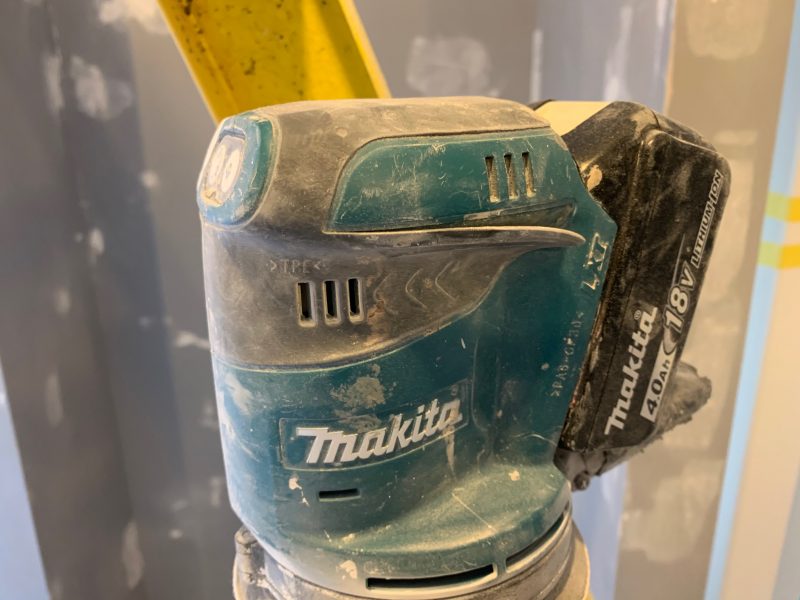
With DeWalt it’s exactly the same story and if you look online for bad reviews of these tools you’ll find that a large number of the lower ratings which aren’t even about the tool themselves are in fact how people feel duped into buying a tool without the battery. The thing is, you have to say the info is there and it they bothered to read this few short sentences here or anywhere else online then they would not have spent their money…enough said about that type of buyer really.
Power
Don’t be confused by power ratings. Corded orbital sanders like the Makita corded orbital sander kick out a lot of power, 300 Watts in fact. But don’t think for one second cordless models are much less powerful at all. The MAKITA CORDLESS RANDOM ORBITAL SANDER isn’t far behind at all with 190 Watts max output. Now considering the latter is free of a power lead it is a massive jump on the corded version. And if you factor the BOSCH PEX 220 is just 220 Watts it’s nearly as powerful as corded versions!
Anything over 150 Watts with an orbital, the way it builds up power and oscillates will give you a smooth timber finish. I’m always using this sander for detail sanding, especially when I’m going to apply teak oil or similar after as the finish is perfectly smooth.
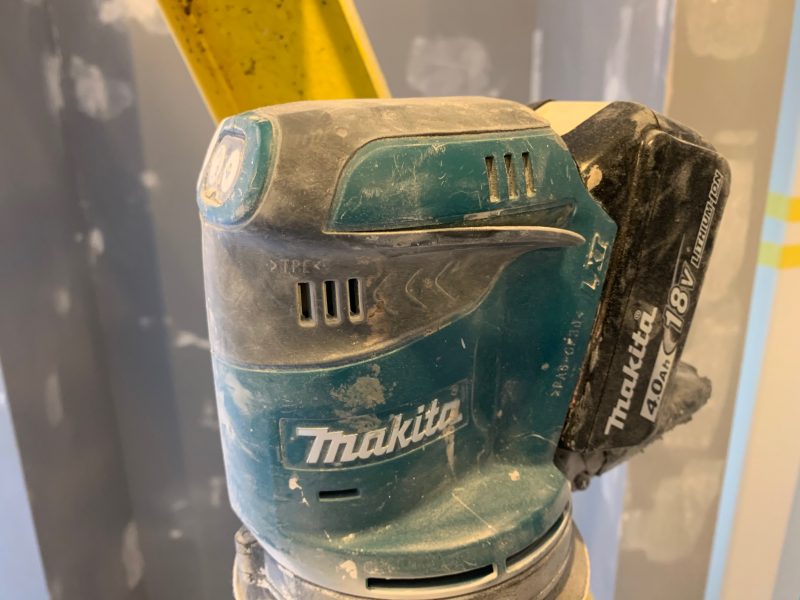
How long is the power lead on a corded orbital sander?
Most of the top models are very generous. I think my DEWALT power lead must be nearly three metres or more as I can move around the ceiling with a reasonable bit of freedom and the ceiling is 2.4m tall without the use of a cable extension reel. Always check how long the power cable is before buying – you don’t want to struggle with a lack of manoeuvrability. This only ends up reducing the quality of the work you do.
How to use an orbital sander
There’s loads of tricks and great ways to improve the use of your orbital sander. For example you can cheat and use your home hoover as the extractor when sanding. You can always use rough sand paper to remove excess rough timber, then change to a finer ‘grit’ for finishing. It’s always important to keep the bases of your sander flat too or you’ll sand your walls and woody with lumps. So here’s a few useful pointers to get you going on how to use an orbital sander:
Dust extractor or use the supplied bag
I would always advocate the use of a dust extractor but if you don’t have one, some duct tape firmly secures your home hoover. It doesn’t matter if it’s good old Henry or the New triton range at screwfix, both this type of hoover work great at reducing the amount of dust in the air.
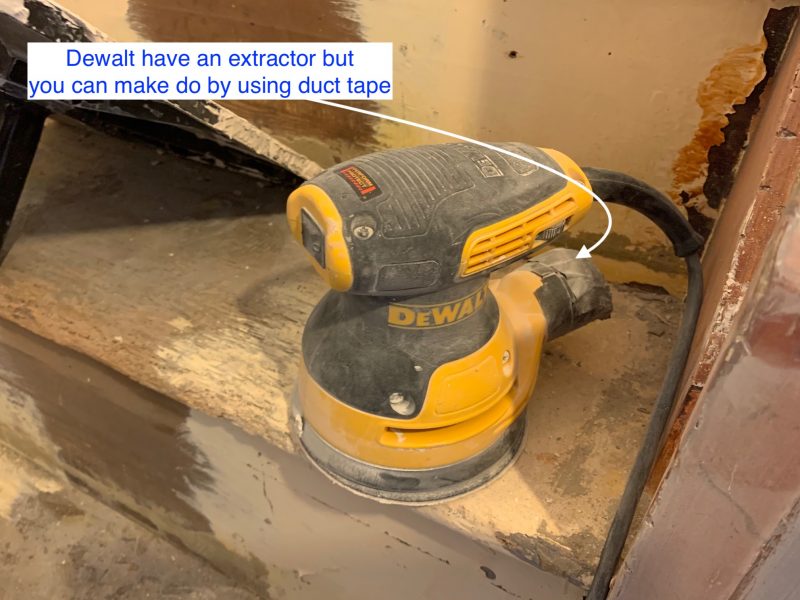
There’s two things you should know about this method. Firstly it’l really clog your filter and secondly it’s not as effective as an actual extractor but really does reduce the airborne dust considerably. You should still want to wear a mask when sanding as no extraction is ever 100% effective.
If you are going to use the bag that’s supplied then make sure you keep your windows open and you should be wearing a mask and goggles if you’re using this tool full stop. Having a window open will be much better for you in the long term especially if you’ve got a lot of sanding to get through.
What grit orbital sanding pads?
Sanding pads work on a downward scale. The lowest being the roughest grit. If you have really nasty plaster or thick filler then you probably want to be using a 60 or 80 grit sand paper to get the worst removed. After this, 120 and 160 grit paper will leave you a lovely finish on timber. If you are hand finishing paint you can get away with a higher grit finish. If you’re using a sprayer then be prepared to sand down to 240 grit. Most workshops will go to this fine grit in order to achieve a superb look. On kitchen cupboards that are sprayed you will see 320 grit sand paper in play too but that’s not needed n the home.
Hopefully this article has given you a pretty sensible rundown of the best orbital sanders in the UK and will aid you in making an informed decision.
Keep your orbital sander flat:
If you raise the sides in order to apply pressure in a smaller area it will definitely help to sand that specific spot faster. However there are a few drawbacks to this. Firstly you burn out the edge of your sanding disc faster and end up changing pads far more frequently, but more importantly: you will end up with timber that is smooth to touch, but lumpy if you run your hand all the way over. So keep your sander flat at all times where possible!
Best orbital sander
So what have we compared to bring the best orbital sander to the top? You need an orbital sander with enough power that it doesn’t kick you off course (this is a huge problem if anywhere near glass), it needs to be comfortable to hold for prolonged periods, and it need to holding onto the Velcro sanding discs firm a seriously firm grip. Is there another worse than those pads slipping and falling off?
So I have to start with my top pick after throughly testing. I am going to go with the Makita orbital sander as the best. Take a look at the full review to find out why 🙂
1. MAKITA DBO180Z 125MM 18V LI-ION LXT CORDLESS RANDOM ORBITAL SANDER
What a super bit of kit. I can tell you straight away that fifteen years ago my best metabo orbital six inch sander only delivered this much power. It makes you wonder what’s coming in the future 🙂 As far as battery tool technology is concerned we are really getting spoilt. Only last week I reviewed Makita cordless routers and confessed that I couldn’t live without it anymore. And the same applies to my cordless planer and cordless nail guns too. It’s all cordless 😀
So what makes this the Makita orbital top pick?
What you’re going to find first off the bat when you pick this sander up is just how nice the soft grip feels in your hand. I have to tell you that’s not the only benefit to the grip either. Being a soft rubber you really can hold this thing without fear of slipping. You don’t need to be a big weight lifter to operate this thing, far from, it’s a very delicate and sophisticated tool. It has serious power delivery for a cordless if you want to look at a little video on a window board:
The power delivery is superb. There is absolutely no kicking at all, you would be forgiven for assuming this thing had a power cord attached it with the sheer raw power it delivers. I use this thing with 60 to 120 grit pads. 60 grit will rip down really rough plaster or filler in seconds. In fact it’s so good I feel like a few pictures are in order 🙂
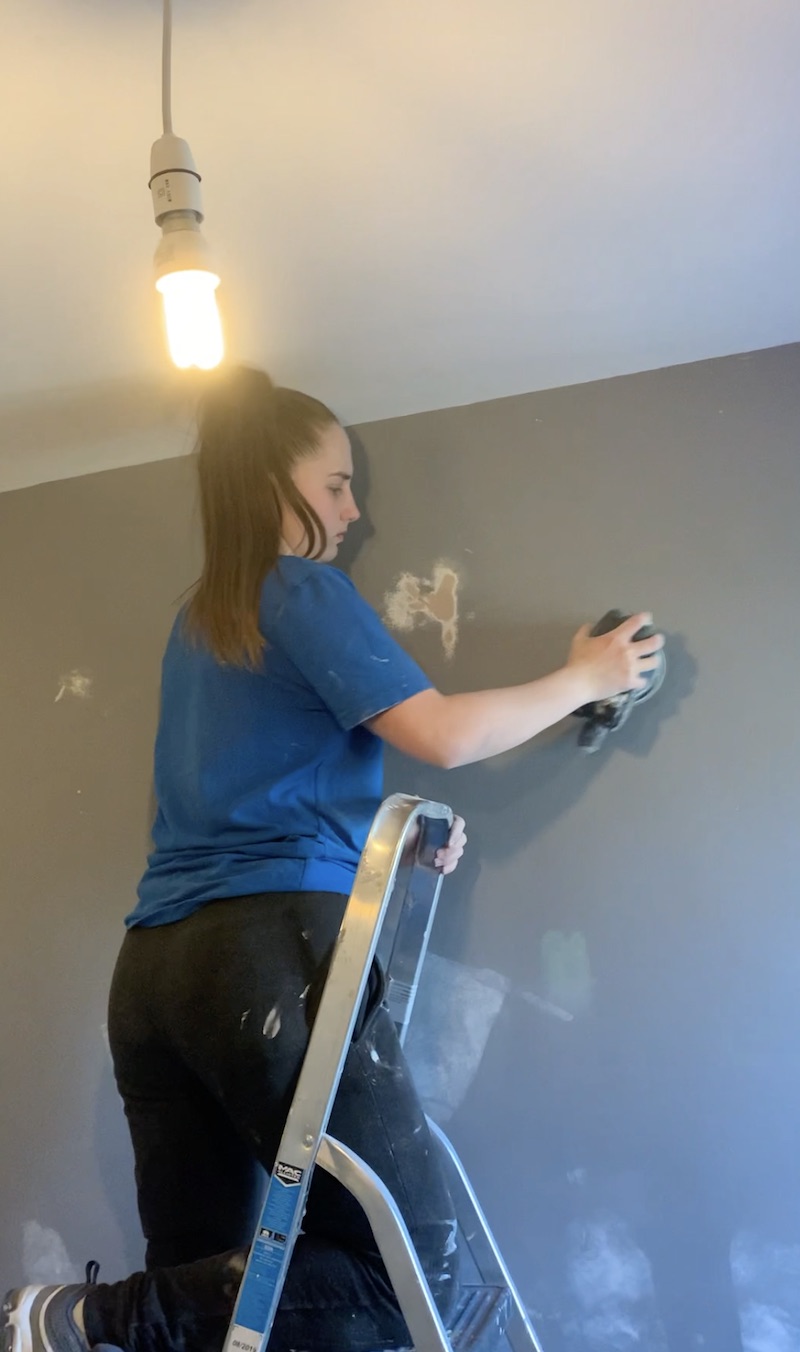
As you can see in literally seconds it’ll clean up the roughest patches of filler. I just want to point out this isn’t really it’s intended use either, it’s just so powerful that it can cross over jobs superbly which saves you money in terms of how many tools you need! What it does even better is sand rough wood. I’m often inclined to use 80 grit first with a bit of wood laced with two part filler. Once I’ve ripped it down to flat I will then either swap over to 120 grit or keep going if the pad has worn down (and resembles a smother finish anyway). The fact I am controlling the grit at all with an orbital sander really should highlight just how much material this sander removes 🙂
In terms of changing sanding pads it’s really easy – you just peel them off and stick them on with the Velcro system.
I would have given the Dewalt top pick but there’s no way I could when the performance is practically identical and one doesn’t have a power lead! To be fair though, the Dewalt cordless performs equally as well too and so that is in the review as well if you have the DeWalt batteries!
I have the extractor for this but I don’t use it. I normally cheat and hookup to any old hoover in the house with a bit of duct tapes. The ultimate bodge tool that every DIY mad person should have. 😀 If I’m on site I would be too embarrassed to do that 😀
There’s 8 suction points under the sander – I highly recommend you buy the standard pads that are compatible with this. You can get them from anywhere really. It’s much better to go with these than buy a pad without holes then have to make your own. It’s becoming common place to extract so you’ll actually find the holed pads more easily than the non holed ones now! Something that’s changed in the last fifteen years as well!
If you don’t have an extractor I find the bag works ok, yeah there’s still loads of airborne dust but it does cut it down a fair bit. It’s certainly better than no extraction method at all!
You can use this sander with almost all the batteries ranging from 1.5amp up to 5 amp. Personally I wouldn’t bother with anything less than 3 amps or you won’t get enough time out of a battery. I find I can sand for about half hour to 45 minutes on a 5 amp battery. There’s a fair bit of variance and that depends on how hard I am working the sander and what setting. You have three to choose from. For walls I go with the toughest setting, for finer sanding the lowest. I recommend you have a play on a test piece of wood to workout what gives you the most control and best finish – this won’t be the same as we are both holding the sander with different pressure…to give you an example, when you use a cordless jigsaw on Pine you’ll get a bit of a rough edge.
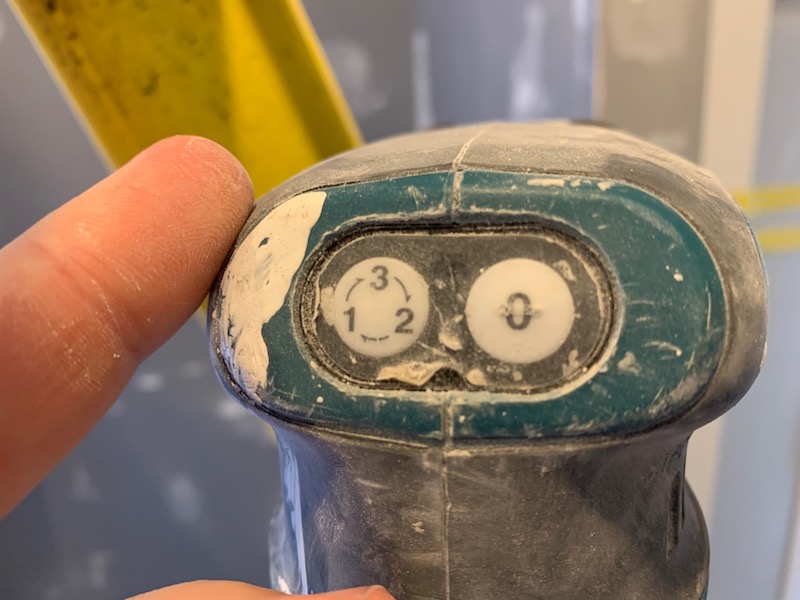
This I would probably use the mid setting to clean up but if you don’t want to push hard at all then probably the top setting would work. Changing settings is easy, just press the power numbered button to select your preferred power setting.
It’s worth mentioning this is a brushed model. Now the war online rages about brushed vs brushless tools. I already have easily a couple of hundred hours on this sander and it’s still powering away like when I bought it new out the box. I really do think too much is being made of brushless when you consider I am a commercial user of tools and still find this to be the best orbital sander in the UK based on price and performance.
2. DEWALT DWE6423-LX 125MM ELECTRIC RANDOM ORBIT SANDER
If I’m honest this orbital sander performs just as well as the Makita cordless. Because they all draw relatively low Watts (between 250-300) they all end up performing almost identically in testing. Most in fact will come down to what make you prefer, and if you have batteries for Makita, Dewalt, Ryobi, and co then you’ll just buy within that range. However, if you don’t want to invest in batteries then you are far more free to pick and choose between brands.
If that is the case I would probably go with the DeWalt and here’s why:
Basically I am not a fan of Dewalt at all. I got caught by the early cordless power tool craze which Makita won because they brought out their cordless trim router first which was a game changer to me. With that said, DeWalt produce solid tooling for a serious DIY’er and even the professionals. The orbital sander is no exception. In my mind this has even less kick than the battery versions. This might be a metal block or real but it certainly translates into more powerful sanding as I’ll often finish a patch before the Makita does.
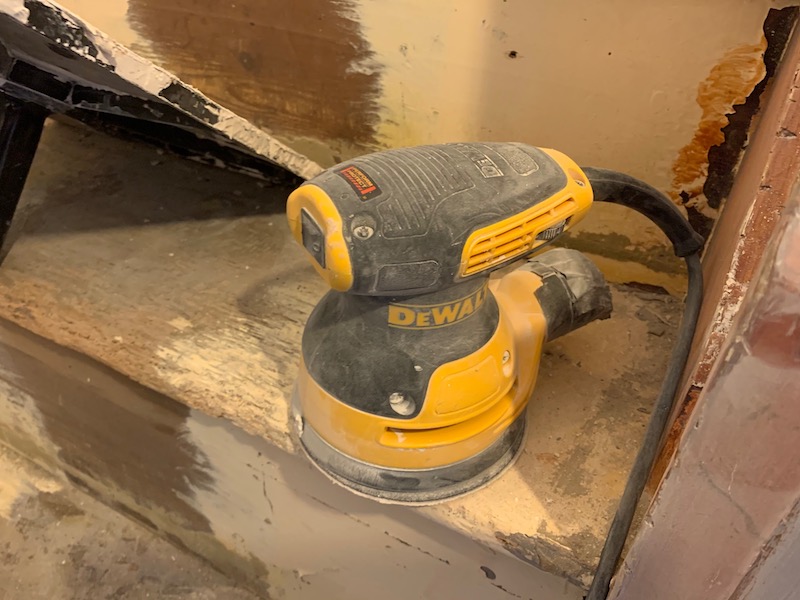
It grips a bit nicer that the Makita too in my opinion. Unless you want to operate the sander two handed this sander feels nicer to hold. The exaggerated curve gives a better feel of holding. The power plea is a generous enough length that you can be working on a standard 2.4m ceiling and not feel too restricted. In fact that’s not even fair, let’s go a step back, the power lead is long enough no problem, where it falls down is the fault of the extractor which isn’t long enough – this is because it’s not the intended use as I mentioned before. However the power delivery makes these little orbitals punch in a much higher weight category than they used to!
The dust extraction works pretty well and very easily changed / emptied. You’ll notice you fill up your dust collector pretty quickly. You could always go with a proper extraction setup which considerably reduces the amount of dust in the air.
It’s a bit of a drain in my opinion to continually move your power reel around following the sander but this is certainly the price you pay for convenience of batteries. A decent DeWalt battery and charger is going to cost you as much as the sander itself which means if you’re just starting out with a cordless kit that you’ll not be getting very good value at all.
3. MAKITA BO5041/2 125MM ELECTRIC RANDOM ORBIT SANDER
The MAKITA BO5041/2 feels very different in the hand to the cordless Makita, in fact it actually feels exactly like the DEWALT DWE6423-LX corded sander. That’s probably because the power lead is dictating the style and grip. I have to say they are similar in performance and price that you could literally flip a coin and get great quality sanding from both. You’d close your eyes and part from the Makita feeling a bit softer in the hand and the extraction bag being cloth you wouldn’t know any different.
Talking about the extraction bags, I prefer the DeWalt as it’s solid. While the Makati doesn’t flop around because it’s small, I feel the solid bag doesn’t get in my eye line so much when I am sanding ceilings upside down. This could also be down to the size too. The Makita collection bag is much wider.
Apart from the feel and shape the performance is practically identical to it’s cordless counterparts. So everything really comes down to whether or not you have the batteries or a good reason to start a cordless battery collection. As a standalone tool though you won’t be disappointed by this in the home. It has loads of power for walls, ceilings, sanding very rough filler, and lighter wood work.
4. Dewalt DCW210N-XJ 18V XR BL Cordless Sander
Literally this is my favourite orbital sander but I just can’t do it. I cannot pay the extra money over the Makita and we are not talking about a few quid here. Standard pricing this sander is a good 50% more money than the cheap cordless orbital Makita. Yeah it performs a bit better but not for the price, I just can’t do it. I can’t pay that extra money.
In the hand it grips far more like the cordless Makita than the DeWalt cored version. This is clearly down to the design shape that having the battery fitted behind the sander then dictates to the overall design.
Being brushless it’s going to last longer than the brushed Makita, it’s also a better power delivery with slightly more control when sanding rough surfaces. You’ll have no trouble with woodwork and if you do pay the money then combine this with the 4 amp battery so the best balance in my opinion.
It’s a super bit of kit, I just can’t justify the price over the base Makita but the DEWALT 20V MAX Orbital Sander is a different story 🙂
5. DEWALT 20V MAX Orbital Sander
What a lovely tool. Completely matches the Makita cordless sander every step of the way and if you have the batteries always then it’s a no brainer. Assuming you don’t have the batteries and you are considering investing in a power tool cordless kit then Makita and DeWalt have to be high up your list. This little sander would be one of the must have tools on my list without question as it can be used for practically anything!
This little sander has enough power to sort out rough ceiling plaster and then comes into its own when sanding woodwork both inside and outside the home. You’ll be amazed as the sander spins you will literally see filler and rough paintwork disperse in a matter of a few short seconds.
This genuinely is a lovely little tool and a definite match in price and quality to the MAKITA DBO180Z. I don’t just think I am of this opinion either. You will literally find thousands of positive reviews of this little bit of kit all over the Internet.
It’s very similar in weight to the Makita as well which makes one handed operation doable. Both weigh not much more than a bag of sugar if that helps to envisage.
In terms of dust extraction the bag does a half decent job and if you’re looking for a complete kit then this little sander is compatible with the DWV010 or DWV012 dust collectors. Either work just as well.
The manufacture doesn’t recommend this for larger jobs like ceilings and wall but I can tell you it’ll do a decent size landing in less than a day. So if you’re looking for a sander small enough for detailed wood work but can stretch to the larger work then this is a top buy!
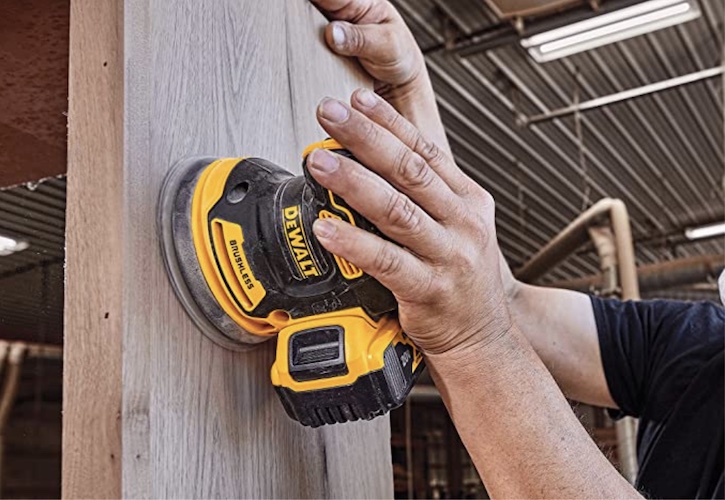
6. BOSCH PEX 220 A Random Orbit Sander
The BOSCH Random Orbit Sander definitely deserved a spot on this top uk palm sander list as budget pick. If you consider it’s as powerful as the top cordless model Makita and generates as many RPM, at half the price plus no need for batteries, it is definitely the best on a budget.
It’s not just me that see’s it that way either. There are literally thousands of reviews of this particular palm sander online and most of them are 5 star feedback.
I quite like the dust bag provided on this. It does a pretty reasonable job of collecting dust considering it’s not an extractor solution but you still want to wear a mask. It’s quite nice in the hands, but it’s bare bones. You don’t get multiple speed selections – it’s just on and off. You’ll also want to but 125mm sanding pads for this – it is the type that are Velcro stick on so no glueing or messing around.
I’d say this sander is absolutely perfect for smaller jobs like sanding hand rails, or a patch or two of rough plaster. Perhaps even revamping kitchen cupboards or the the front or back door.
As far as complaints go some say it’s underpowered. I would agree the 190 Watts of the Makita cordless produces much more power than the 220 Watts corded that’s rated on this. That said, the Makita is double the price. If you’re going to go steady and not looking to break speed records then this is a good choice still.
There’s a couple of complaints about breaking down too. I’d say literally less than one in a thousand units fail. I’m not going to throw Bosch under the bus for that either – it’s a quality palm sander for use at home.






















